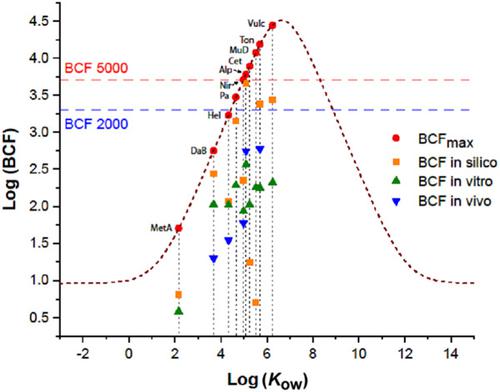当前位置:
X-MOL 学术
›
Environ. Toxicol. Chem.
›
论文详情
Our official English website, www.x-mol.net, welcomes your
feedback! (Note: you will need to create a separate account there.)
In Vitro Biotransformation Assays Using Liver S9 Fractions and Hepatocytes from Rainbow Trout (Oncorhynchus mykiss).
Environmental Toxicology and Chemistry ( IF 3.6 ) Pub Date : 2020-09-11 , DOI: 10.1002/etc.4872 Christian Kropf 1 , Frédéric Begnaud 2 , Sylvia Gimeno 3 , Fabienne Berthaud 2 , Christian Debonneville 2 , Helmut Segner 1
Environmental Toxicology and Chemistry ( IF 3.6 ) Pub Date : 2020-09-11 , DOI: 10.1002/etc.4872 Christian Kropf 1 , Frédéric Begnaud 2 , Sylvia Gimeno 3 , Fabienne Berthaud 2 , Christian Debonneville 2 , Helmut Segner 1
Affiliation

|
In vitro metabolic stability assays using rainbow trout (Oncorhynchus mykiss) isolated hepatocytes (RT‐HEP) or hepatic S9 fractions (RT‐S9) were introduced to provide biotransformation rate data for the assessment of chemical bioaccumulation in fish. The present study explored the suitability of the RT‐HEP and RT‐S9 assays for difficult test chemicals, and the in vitro–based predictions were compared to in silico–based predictions and in vivo–measured bioconcentration factors (BCFs). The results show that volatile or reactive chemicals can be tested with minor modifications of the in vitro protocols. For hydrophobic chemicals, a passive dosing technique was developed. Finally, a design‐of‐experiment approach was used to identify optimal in vitro assay conditions. The modified assay protocols were applied to 10 fragrances with diverse physicochemical properties. The in vitro intrinsic clearance rates were higher in the S9 than in the hepatocyte assay, but the in vitro–in vivo (IVIV) predictions were comparable between the 2 assays. The IVIV predictions classified the test chemicals as nonbioaccumulative (BCF < 2000), which was in agreement with the in vivo data but in contrast to the in silico–based predictions. The findings from the present study provide strong evidence that the RT‐HEP and RT‐S9 assays can provide reliable estimates of in vivo biotransformation rates for test chemicals with difficult physicochemical properties. Environ Toxicol Chem 2020;39:2396–2408. © 2020 SETAC
中文翻译:

使用来自虹鳟鱼(Oncorhynchus mykiss)的肝S9馏分和肝细胞进行体外生物转化测定。
引入了使用虹鳟(Oncorhynchus mykiss)分离的肝细胞(RT-HEP)或肝S9馏分(RT-S9)进行的体外代谢稳定性测定,以提供生物转化率数据来评估鱼类中的化学生物蓄积性。本研究探讨了RT-HEP和RT-S9测定法对难测化学药品的适用性,并将基于体外的预测与基于计算机模拟的预测以及体内的预测进行了比较。测量的生物浓缩因子(BCF)。结果表明,可以对挥发性化合物或反应性化学药品进行体外协议稍作修改即可对其进行测试。对于疏水性化学品,开发了一种被动定量给料技术。最后,实验设计方法用于确定最佳的体外测定条件。修改后的测定方案应用于10种具有多种理化特性的香料。S9的体外固有清除率高于肝细胞分析,但两种方法之间的体外-体内(IVIV)预测是可比的。IVIV的预测将测试化学物质归类为非生物蓄积性(BCF <2000),这与体内数据一致,但与计算机模拟相反–基于的预测。本研究的发现提供了有力的证据,证明RT-HEP和RT-S9分析可以为具有困难的理化性质的测试化学品提供可靠的体内生物转化率估计。Environ Toxicol Chem 2020; 39:2396-2408。©2020 SETAC
更新日期:2020-09-11
中文翻译:

使用来自虹鳟鱼(Oncorhynchus mykiss)的肝S9馏分和肝细胞进行体外生物转化测定。
引入了使用虹鳟(Oncorhynchus mykiss)分离的肝细胞(RT-HEP)或肝S9馏分(RT-S9)进行的体外代谢稳定性测定,以提供生物转化率数据来评估鱼类中的化学生物蓄积性。本研究探讨了RT-HEP和RT-S9测定法对难测化学药品的适用性,并将基于体外的预测与基于计算机模拟的预测以及体内的预测进行了比较。测量的生物浓缩因子(BCF)。结果表明,可以对挥发性化合物或反应性化学药品进行体外协议稍作修改即可对其进行测试。对于疏水性化学品,开发了一种被动定量给料技术。最后,实验设计方法用于确定最佳的体外测定条件。修改后的测定方案应用于10种具有多种理化特性的香料。S9的体外固有清除率高于肝细胞分析,但两种方法之间的体外-体内(IVIV)预测是可比的。IVIV的预测将测试化学物质归类为非生物蓄积性(BCF <2000),这与体内数据一致,但与计算机模拟相反–基于的预测。本研究的发现提供了有力的证据,证明RT-HEP和RT-S9分析可以为具有困难的理化性质的测试化学品提供可靠的体内生物转化率估计。Environ Toxicol Chem 2020; 39:2396-2408。©2020 SETAC











































 京公网安备 11010802027423号
京公网安备 11010802027423号